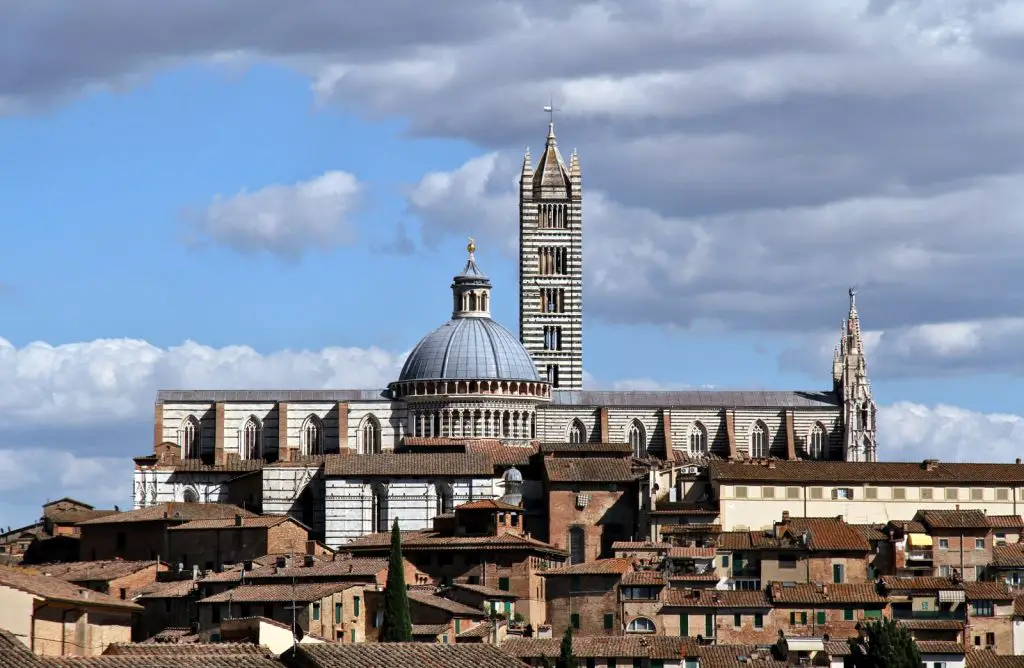Siena
On the other side of the Chianti countryside from Florence is Siena, a Tuscan town rife with tradition and mood.
Siena is best known as the site of the Palio. This twice-yearly, bareback horserace is held in the central Piazza del Campo, the heart of this UNESCO city.
The Palio is a race that can be traced as far back as the early 13th century. It pits a rotating roster of 10 of the city’s 17 contrade (neighborhoods) against one another. Run on July 2 and August 16, the Palio is Siena’s most famous local event and one of the most popular events in Tuscany. The event today draws scads of spectators from all over Italy and abroad.
Beyond the pageantry of the Palio, Siena is a glorious city for pedestrians. The compact city center is car-free and quiet enough to hear the cobblestones resonate underfoot.
Siena Map
What to Do in Siena
In addition to the Palio, Siena’s cityscape awes, with art and architecture around every bend.
The tight warren of shadowy streets empties into Piazza del Campo, one of the finest medieval squares in Europe. Divided into nine sectors—a nod to the Council of Nine—the shell-shaped piazza is the city’s main meeting point. It is surrounded by numerous restaurants and outdoor cafes, almost all of which have tourist trap prices.
At the base of the shell lies the Palazzo Pubblico. Built in the late 13th/early 14th centuries, the “palace of the people” houses two masterpieces by native son Simone Martini. Another artistic attraction here is an amusing fresco series depicting “good and bad government.”
Next door to the Palazzo Pubblico rises the Torre del Mangia, one of the tallest bell towers in Italy. Climb the 505 steps to the top and enjoy the views of rooftops and the Campagna Senese (Sienese countryside).

Also within view from the tower is Siena’s spectacular Duomo, a massive, black-and-white striped cathedral renowned for its interior pavements. The pavements, featuring sybils, angels, saints, and biblical scenes, are usually unveiled in their entirety in September. However, a small portion of the 56 floor panels is visible to viewers on a rotating basis throughout the year.
Siena is the birthplace of Saint Catherine, the co-patron saint of Italy (in tandem with Saint Francis). Visit the Basilica of San Domenico and the Shrine of Santa Caterina to see where the saint lived and worshipped. (Note: Her tomb is located in Rome in the church of Santa Maria Sopra Minerva.)
If you want to learn more about each district, pay a visit to one—or several—of Siena’s 17 Contrada museums. On proud display are banners, relics, and costumes from Palio contests of yore.

Best Tours in and Around Siena
Siena is not only a great city to visit on its own. But it is also a good base for exploring southern Tuscany.
The province of Siena includes many notable towns. Four of Tuscany’s seven UNESCO sites are in Siena’s province, including the historic centers of Siena, Pienza, and San Gimignano. The landscape of the Val d’Orcia is also recognized as a UNESCO World Heritage Site.
- Tuscany Day Trip From Florence With Chianti, Siena and San Gimignano
- Val d’Orcia Small Group Tour from Siena
Siena and its province also provide many opportunities for visits to vineyards and olive groves. Look for these in Montalcino, Montepulciano, and in the towns of the Chianti sub-region, including Castellina in Chianti.
- Brunello Full-Day Tour
- Medieval Castles & Chianti Wine Tasting Tour with Lunch
- Chianti Bike Tour with Wine Tasting
Where to Stay in Siena
There are tons of agriturismo (farm stay) inns and self-catering options on the outskirts of Siena. These are ideal places to stay if you’re touring Tuscany by car.
Retreat to the well-appointed Hotel Santa Caterina, which is set just outside the Porta Romana. Or, stay in Villa Scacciapensieri, where you can “forget your troubles” while soaking in views of Siena and the countryside.
If you want to stay in town, consider Hotel Duomo because its upper floors offer rooftop views.
Getting There
The closest international airport to Siena is Pisa’s Galileo Galilei Airport. You can take a train from Pisa airport to Pisa Centrale. Then, then you can take a regional train from Pisa to Siena. The one-way trip will take about 1.5-2 hours.
Many people go to Siena from Florence, either as a day trip or part of a larger Tuscany circuit. Regional trains from Florence to Siena also take about 1.5-2 hours.
Getting to Siena by car is easy and quite scenic if you take local roads. The SS-222 from Florence to Siena takes you past the olive groves and vineyards of Chianti. You can access the SS-222 via the A1 autostrada, which is a direct route from Rome to Florence. Siena is about halfway between the two cities.
